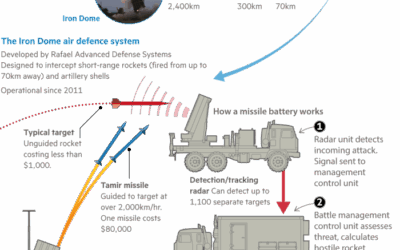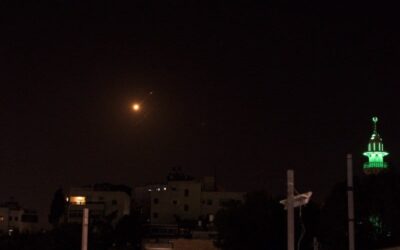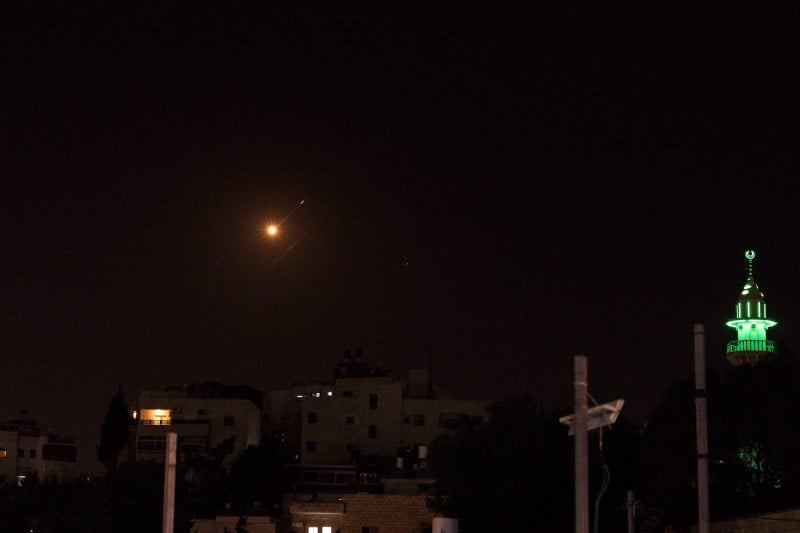A Victory for Israel

A Victory for Israel
Israel’s strikes keep Iran out of the nuclear club.
A view of the skyline in Tehran on June 13. Hossein Beris/AFP via Getty Images
Israel carried out a wave of attacks against Iran early on June 13 local time, hitting key nuclear and military targets and meaningfully setting back Iran’s nuclear program. What comes next? If Israel is willing to maintain its current policy, then the answer is a major foreign-policy victory for Jerusalem and Washington.
As I have been arguing for more than a decade, the Iranian nuclear crisis was bound to end in military action. Simply acquiescing to a nuclear-armed Iran would have posed unacceptable risks.
Israel carried out a wave of attacks against Iran early on June 13 local time, hitting key nuclear and military targets and meaningfully setting back Iran’s nuclear program. What comes next? If Israel is willing to maintain its current policy, then the answer is a major foreign-policy victory for Jerusalem and Washington.
As I have been arguing for more than a decade, the Iranian nuclear crisis was bound to end in military action. Simply acquiescing to a nuclear-armed Iran would have posed unacceptable risks.
Negotiating permanent limits on Iran’s nuclear program would have been the best outcome, but such a deal proved elusive after more than two decades of talks. Former U.S. President Barack Obama’s 2015 deal, known as the Joint Comprehensive Plan of Action, was weak and had limits that expired over time, providing Iran with a patient path to the bomb. President Donald Trump rightly pulled out of that agreement in his first term, and Iran has been unwilling to agree to a more restrictive deal in the years since. Cyberattacks and sabotage have slowed the program, but they were never going to be enough to stop it completely. So, military action was the only option remaining.
Israel exercised that option as a last resort in its latest attack. Iran’s dash time to enrich enough uranium for one nuclear weapon had shrunk down to mere 2.5 days and, earlier this week, the International Atomic Energy Agency formally censured Iran—the first time in 20 years—for being in noncompliance with its obligations under the Nuclear Non-Proliferation Treaty (NPT).
A key question now is how much damage will Israel be able to inflict on Iran’s nuclear program? There are three key nuclear facilities in Iran: Isfahan, Natanz, and Fordow. All of them were struck, but there is no word yet on the extent of the damage. Fordow is buried in the side of a mountain. It will be difficult for Israel to destroy the facility with airstrikes alone.
Still, don’t count Israel out. No one predicted Israel would decimate Hezbollah with exploding pagers and walkie-talkies until it happened last fall. Perhaps Israel can destroy Fordow with commando raids or some other ingenuous and unexpected style of attack. The United States, with its heavy bombers and bunker-busting munitions, can destroy Fordow from the air. The Defense Department has remained out of the offensive operations so far, but Washington could be persuaded, either by Israeli entreaties or Iranian retaliation, to come in and finish the job.
How will Iran retaliate to Israel’s strikes? Many fear a wider war, but this is unlikely. Iran’s ability to retaliate has been badly degraded over the past year. Hamas and Hezbollah have been decimated in the conflicts that followed Hamas’s Oct. 7, 2023, attack on Israel. Israel has strong air and missile defenses, which were effective at shooting down the Iranian missile and drone attacks that occurred in April and October of last year. On June 13, Iran launched approximately 100 drones in retaliation to the Israeli attack, but some have been shot down, and there is no reported damage inside Israel.
Still, Iran has other dangerous retaliatory options. It could activate terror and proxy groups to conduct attacks on soft targets in the region or around the world. On June 11, in order to reduce exposure to this kind of attack, the United States withdrew its diplomats and other nonmilitary personnel from its embassy in Iraq and authorized the voluntary departure of military families across the Middle East.
Iran could harass and attack ships in the Persian Gulf. It could even attempt to close the Strait of Hormuz, but this would obstruct its own energy exports and main source of revenue, as well as antagonize much of the rest of the world, including countries—like China—that Tehran will count on for diplomatic support.
In its 2025 worldwide threat assessment, the U.S. intelligence community found that Iran “probably is pursuing central nervous system-acting chemicals for offensive purposes” and has “probably not abandoned its intention to conduct research and development of biological agents and toxins.” So, the next salvo of missiles coming at Israel or U.S. bases could be armed with weapons of mass destruction.
But Iranian leaders know that if they go too far, they risk provoking a major war with the United States—a contingency that could very well lead to the end of their regime.
Some commentators have expressed hope that the Israeli strikes could precipitate the fall of the Iranian regime, but that is unlikely. To be sure, this war will materially weaken the regime. But the sad reality is that Iranian leaders have been willing to kill civilians for many years to stay in power, and the Iranian people have not been willing to die in large enough numbers to rise up and seize it. Nothing from the latest strikes suggest that this calculation has changed.
Perhaps the biggest remaining question is one that will play out over the coming weeks and months: whether and when Iran will rebuild its nuclear program. Critics of strikes on Iran’s nuclear facilities have argued that any attack could cause Tehran to formally withdraw from the NPT and dash to a bomb. But Iran cannot build nuclear weapons without uranium enrichment facilities and material. If Israel’s strikes are successful, they will delay Iran’s program by at least a year or two.
If Iran rebuilds in the future, Israel always has the option to strike again—a contingency that Israeli military officials call “mowing the grass.” But Iran’s supreme leader, Ayatollah Ali Khamenei, has spent decades and billions of dollars on the country’s nuclear program, only to have key facilities turned into piles of rubble. Would he really want to hit replay on that tape?
Trump is attempting to use the leverage created by the strikes as an opening for negotiations. “There is still time to make this slaughter … come to an end. Iran must make a deal, before there is nothing left,” he posted on social media.
I hope that Khamenei accepts the offer, but I suspect that he will not. If he absorbs an attack from Israel and then capitulates on his long-standing claim of a “right to enrich” in negotiations with the United States, he will look weak in front of his core supporters in the military and clerical establishment. That is something that could pose a real risk to his rule.
The most likely outcome, therefore, is that Israel’s strikes will do significant damage to Iran’s nuclear program. Khamenei will remain defiantly in power, clinging to his self-proclaimed “right to enrich.” He will absorb Israel’s strikes and retaliate. His efforts to hit back will be enough to save face among his domestic supporters but not enough to cause catastrophic damage in Israel or beyond.
After the dust settles, Iran will continue its antagonism to Israel and the United States, but, at least for the foreseeable future, Iran’s resistance will not be backed by the power of nuclear weapons. We have learned this week that Israel is willing to go to war to stop Iran from building nuclear weapons. So long as this remains true, Iran will not join the nuclear club.
The world has struggled for more than two decades to stop one of the globally leading state sponsors of terror from building the deadliest weapon known to humankind. Israel’s actions this week have brought the world closer to that goal.
This post is part of FP’s ongoing coverage. Read more here.
Matthew Kroenig is a columnist at Foreign Policy and vice president and senior director of the Atlantic Council’s Scowcroft Center for Strategy and Security and a professor in the Department of Government and the Edmund A. Walsh School of Foreign Service at Georgetown University. His latest book, with Dan Negrea, is We Win, They Lose: Republican Foreign Policy and the New Cold War. X: @matthewkroenig
Stories Readers Liked
In Case You Missed It
A selection of paywall-free articles

Four Explanatory Models for Trump’s Chaos
It’s clear that the second Trump administration is aiming for change—not inertia—in U.S. foreign policy.























Join the Conversation
Commenting is a benefit of a Foreign Policy subscription.
Subscribe
Subscribe
Already a subscriber?
.
View Comments
Join the Conversation
Join the conversation on this and other recent Foreign Policy articles when you subscribe now.
Subscribe
Subscribe
Not your account?
View Comments
Join the Conversation
Please follow our comment guidelines, stay on topic, and be civil, courteous, and respectful of others’ beliefs.
View Comments
Change your username |
Log out
Change your username:
CANCEL
Confirm your username to get started.
The default username below has been generated using the first name and last initial on your FP subscriber account. Usernames may be updated at any time and must not contain inappropriate or offensive language.